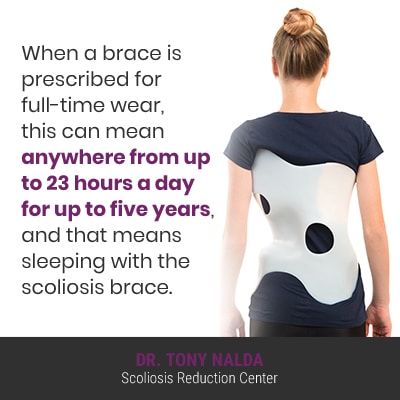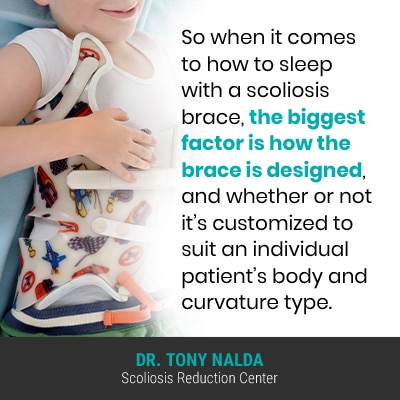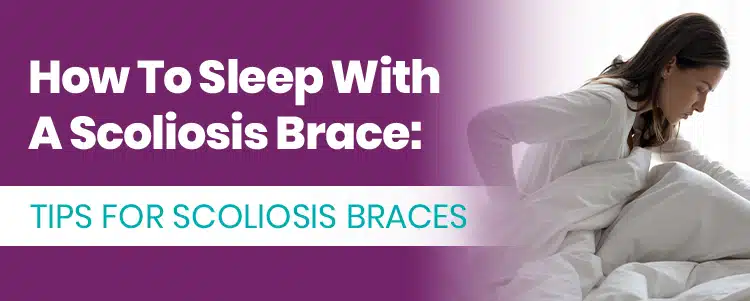There are two main scoliosis treatment approaches to choose between: traditional and conservative. For those wanting to avoid the need for invasive spinal surgery in the future, conservative treatment is proactive and works towards corrective results; corrective bracing is known to be more effective and comfortable than traditional bracing. Continue reading to find out why.
If a scoliosis brace is prescribed for full-time wear, it generally needs to be worn at night. Sleeping in a customized corrective ScoliBrace can be different from a mass-produced traditional scoliosis brace.
When it comes to scoliosis bracing, it’s most commonly used in the treatment of adolescent idiopathic scoliosis, so let’s start there.
What is Adolescent Idiopathic Scoliosis?
Not only does scoliosis range widely in severity from mild to moderate and severe to very severe, there are also different condition types a person can develop, and this is determined by causation.
The most common type of scoliosis to affect both children and adults is idiopathic scoliosis, meaning not clearly associated with a single-known cause, and this form accounts for approximately 80 percent of known diagnosed cases.
The remaining 20 percent are associated with known causes: neuromuscular scoliosis, degenerative scoliosis, and congenital scoliosis.
Neuromuscular scoliosis is caused by the presence of a larger neuromuscular condition; degenerative scoliosis is caused by natural age-related spinal degeneration, and congenital scoliosis is caused by a malformed spine that develops in utero.
While we don’t fully understand what causes the initial development of idiopathic scoliosis, we do know what triggers it to progress: growth and development.
So a big focus of treating scoliosis in children is how to counteract the condition’s progressive nature, despite the constant trigger of growth occurring.
Adolescent idiopathic scoliosis (AIS) is the most prevalent type overall, and when it comes to scoliosis bracing, it’s most commonly used for treating AIS, so we’ll focus on this condition type for our current purposes.
When it comes to choosing an effective scoliosis brace, this will depend on the chosen treatment approach; traditional treatment has the end goal of stopping progression so opts for a brace that complements that goal, while conservative treatment has the end goal of achieving corrective results, so uses an ultra-corrective brace.
Traditional vs Modern Scoliosis Braces
One of the best tips I have for scoliosis braces is to choose one that’s effective as part of treatment because it has corrective potential, and that’s a modern corrective brace.
Traditional scoliosis bracing is limited in its potential efficacy for a number of reasons, the main one being that it only addresses scoliosis a 2-dimensional condition, when its rotational component makes it a complex 3-dimensional spinal condition.
A scoliotic spine doesn’t just bend unnaturally to the side, but also twists, making it a complex 3-dimensional condition, and in order to be treated effectively, its rotational component also has to be addressed.
Traditional scoliosis bracing also has the end goal of holding a curve (stopping progression), but not correcting it, and traditional braces are mass produced and aren’t adjusted throughout the course of treatment; scoliosis is not a static condition so is always changing.

Where a scoliosis is at the time of diagnosis is not indicative of where it will stay, and where a scoliosis is at the onset of treatment isn’t indicative of where it will stay, particularly if treatment is working, which is why it has to be constantly adjusted; only proactive treatment can work towards counteracting the condition’s progressive nature throughout growth.
Even though we don’t always know what causes idiopathic scoliosis to develop, I remind patients that fully understanding its causation wouldn’t necessarily change the course of treatment or its outcome, and being proactive is key.
Traditional scoliosis braces, such as the boston brace, are made from a rigid plastic material, and as they are not fully customized, they are more bulky and noticeable, uncomfortable to wear, difficult to take on and off, and all of these factors affect its rate of compliance.
One of the reasons bracing is often ineffective as a facet of scoliosis treatment is that its success is based on compliance, and when we’re talking about adolescent patients who just want to fit in with their peers, wearing a brace full time doesn’t facilitate that.
In addition, the more uncomfortable the brace, the harder it is to participate in certain sports and activities.
When a brace is prescribed for full-time wear, this can mean anywhere from up to 23 hours a day for up to five years, and that means sleeping with the scoliosis brace.
Scoliosis is already associated with sleep problems due to pain and difficulty getting comfortable at night, and when wearing a scoliosis brace is added to that, sleeping with scoliosis can pose additional challenges.
Sleeping With a Corrective Scoliosis Brace
Corrective bracing, such as the ultra-corrective ScoliBrace, is the brace of choice when it comes to conservative treatment of adolescent idiopathic scoliosis; the ScoliBrace represents the culmination of what we’ve learned about scoliosis and treatment efficacy over the years.
The ScoliBrace has corrective results as its end goal, and it augments these by pushing the spine into a corrective position; traditional braces squeeze the spine unnaturally, weakening it over time, causing breathing difficulties and making the brace more uncomfortable to wear, particularly during sleep.
Traditional bracing is mass produced, is designed around a single set of measurements taken at the onset of treatment, but isn’t adjusted based on how the spine is responding to growth and treatment; whereas the corrective ScoliBrace is constantly adjusted and re-designed to address the patient’s changing spine and treatment needs.
Customization = Comfort

The ScoliBrace is custom-designed to ensure that every brace is fully bespoke to its wearer, and this is achieved through state-of-the-art technology and scanning software to ensure that each brace is custom-designed around an individual patient’s body/curvature type.
The more comfortable a brace is, the more likely it is to work as prescribed, and while there are no scoliosis-bracing treatment guarantees, compliance does improve the likelihood of treatment-success.
The ScoliBrace also offers ScoliNight: a brace specifically designed to address smaller flexible curves in younger patients while they sleep; in these types of cases, a brace needs to be worn during sleep throughout peak hours of growth, and because these young patients’ spines are so flexible, they are more responsive to bracing.
So when it comes to how to sleep with a scoliosis brace, the biggest factor is how the brace is designed, and whether or not it’s customized to suit an individual patient’s body and curvature type.
Modern corrective braces use state-of-the-art computer software and scanning technology to take a series of comprehensive measurements and images to ensure that each brace is custom-designed, making it more comfortable, easy to get on and off, more likely to be worn full time as prescribed, and more comfortable to sleep in.
Conclusion
A brace that’s designed to be worn at night, and is fully customized to address a patient’s body and curvature type, is going to be more comfortable and easier to sleep in.
If a scoliosis brace is uncomfortable and/or bulky to wear, it’s unlikely to be worn full time as prescribed, is likely to be difficult to sleep in, lowering potential compliance even further, and this impacts potential treatment-success.
When it comes to wearing a scoliosis brace at night, make sure it’s a corrective brace with corrective potential, and in order to be considered corrective, it has to address the condition’s true 3-dimensional nature.
A brace that’s only measured once at the onset of treatment, but not throughout so it can be adjusted accordingly, is also unlikely to be as effective or comfortable to sleep in.
Here at the Scoliosis Reduction Center®, I opt for the ultra-corrective modern ScoliBrace to meet my patients’ scoliosis bracing needs; this brace has corrective potential and addresses many of the shortcomings associated with traditional bracing.
Braces with corrective potential facilitate corrective results by pushing the spine into a healthier alignment and position, while traditional scoliosis braces are less comfortable because they squeeze the spine unnaturally.
In addition, as traditional braces, like the boston, are mass produced and designed based on a single set of measurements, they are less comfortable to wear and sleep in.
It should be clearly stated, however, that no scoliosis brace, on its own, can correct a scoliosis – it has to be integrated into a proactive treatment plan that combines a number of scoliosis-specific treatment disciplines: chiropractic care, physical therapy, and rehabilitation.




